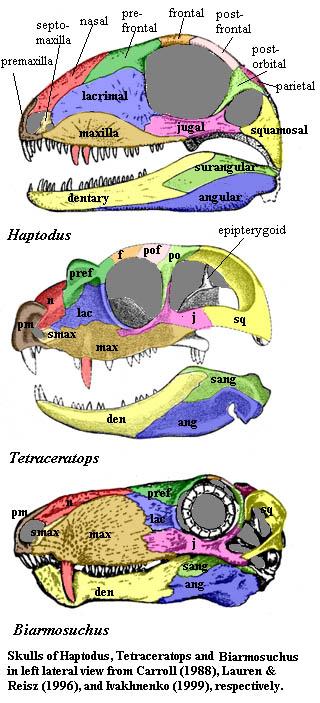
Septomaxilla-3
| Palaeos: |  |
Bones: Dermal Bones |
| Vertebrates | Facial Series: Septomaxilla-3 |
| Page Back | Unit Back | Unit Home | Unit References | Unit Dendrograms ("Cladograms") |
Glossary | Taxon Index |
| Page Next | Unit Next | Vertebrates Home | Vertebrate References | Vertebrate Dendrograms | Bones | Time |
|
Bones
|
Dermal Bones
Facial Series |
Facial Series
|

It has been reported that the nasolacrimal duct opens into the vomeronasal organ in both synapsids and lepidosaurs. Hillenius (2000). This may well explain the relative success of the septomaxilla in these two lineages. In any event, the septomaxilla is a relatively large, Type A structure in pelycosaurs. It may also have had a role in giving some minor flexibility to the snout, as it tends to insert ventrally between the maxilla and premaxilla, and dorsally between the nasal and premaxilla. This last character is best developed in sphenacodonts, and particularly in Haptodus. In the basal therapsids, this character is very marked, and the elongate posterior extension of the septomaxilla on the external skull is considered a strong synapomorphy of Therapsida.
The septomaxilla is lost in several synapsid branches, including the anomodonts and most therian mammals, presumably coincident with the uncoupling of the nasolacrimal duct from the vomeronasal organ. However, the bone is rather persistent otherwise, and has been identified, for example, in tritylodontids, Morganucodon, Gobiconodon, and monotremes, although it is absent in multituberculates.
What is difficult to explain is the presence of a septomaxilla in the Xenarthra. This may be an argument for a pacing them outside the Eutheria. However, it more likely another case of a non-homologous neomorph.
The septomaxilla is, obviously, a bone characterized by ambiguities. It probably originates from the anterior tectal of osteolepiforms, where it depended from the nasal and flexibly covered part of the external naris -- a Type C conformation. On the other hand, a lateral rostral origin cannot be ruled out. The lateral rostral looks much more like a Type B septomaxilla and a clear Type C is known only from Acanthostega and Ichthyostega.
The septomaxilla is highly mutable in anamniote groups. Both its form and presence seem labile on a family level. However, among the amniotes, we find great stability in some lineages and permanent loss in others. This stability appears to be linked to a tight association with the nasolacrimal duct. However, the connection with the vomer and the vomeronasal organ can't be eliminated, either. In fact, its greatest success is among the squamates, where it plays an increasingly important palatal role in more derived species.
This is all a puzzle that anatomists are unlikely to be able solve alone. Eventually, we have argued, we will need a much deeper understanding of the fine points from molecular developmental biology. ATW040312.
[1] However, we do have remarkably complete developmental series for one osteolepiform, Eusthenopteron. See Cote et al. (2002). Possibly something could be learned from an examination of these fossils.
[2] In fact, Clack refers to the bone in both cases as an "anterior tectal".
[3] Although we have left the typology of the early tetrapods behind, not how the enlarged septomaxilla of snakes incorporates the characteristics of all three basal septomaxilla types. It is associated with the nasolacrimal duct as in Type A, bears a dorsal process within the nasal cavity as in Type B, and is strongly bound to the nasal, as in Type C.
| Page Back | Unit Home | Glossary | Page Top | Page Next |
checked ATW050520